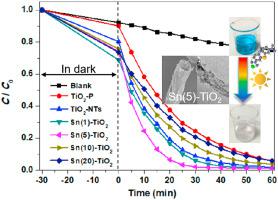当前位置:
X-MOL 学术
›
Ceram. Int.
›
论文详情
Our official English website, www.x-mol.net, welcomes your
feedback! (Note: you will need to create a separate account there.)
A biotemplate synthesized hierarchical Sn-doped TiO2 with superior photocatalytic capacity under simulated solar light
Ceramics International ( IF 5.1 ) Pub Date : 2020-11-01 , DOI: 10.1016/j.ceramint.2020.11.181 Jiao Li , Jiao Shi , Yuanbiao Li , Zhanlai Ding , Jianguo Huang
Ceramics International ( IF 5.1 ) Pub Date : 2020-11-01 , DOI: 10.1016/j.ceramint.2020.11.181 Jiao Li , Jiao Shi , Yuanbiao Li , Zhanlai Ding , Jianguo Huang

|
Abstract Despite a number of studies have been carried out on TiO2 based materials as photocatalysts for water pollutant treatment, it still needs sustained effort to extend the optical range of the photocatalysts and inhibit the recombination of photo-induced carriers to improve their catalytic activities under solar light. In this work, a series of Sn-doped TiO2 with different amounts of Sn doping (1, 5, 10 and 20 mol%) were biomimetically synthesized by a facile sol–gel method using cellulosic cotton as biotemplate. The Sn-doped TiO2 materials possess a typical three-dimensional hierarchical structure of microtubes consisting of interwoven nanofibers. The photocatalytic performance was evaluated via the degradation of methylene blue (MB) (10.0 mg L−1) under Xenon lamp simulated solar irradiation. The results show that Sn(5)-TiO2 (5 mol% Sn doping) sample exhibits an outstanding photocatalytic capacity with a superior degradation rate of higher than 98% within 30 minutes and a good reusability without significant decrease of activity after reused for four cycles. The most significantly improved photocatalytic capacity of TiO2 is ascribed to more extra surface hydroxyl groups and accessible active sites provided by the relatively high surface area, and a higher light capturing and utilization efficiency with less recombination of the photogenerated electron-hole pairs endowed by the good synergistic effect of the special hierarchically porous microstructure and the appropriate amount of Sn doping. Whereas, the excessive Sn doping reduces the photocatalytic activity obviously, resulting from the phase transformation of TiO2 generating more rutile phase with less reactivity, the phase separation with clear grain boundary blocking the active sites, and the extra Sn4+ acting as the recombination center. This research presents a facile biomimetic synthesis strategy combined with the traditional sol–gel method to develop various ion doped metal oxides as photocatalysts with enhanced activity.
中文翻译:

一种生物模板合成的分级 Sn 掺杂 TiO2 在模拟太阳光下具有优异的光催化能力
摘要 尽管已经对 TiO2 基材料作为光催化剂用于水污染物处理进行了大量研究,但仍需要持续努力以扩展光催化剂的光学范围并抑制光致载流子的复合以提高其在太阳光下的催化活性。光。在这项工作中,使用纤维素棉作为生物模板,通过简便的溶胶-凝胶法仿生合成了一系列具有不同 Sn 掺杂量(1、5、10 和 20 mol%)的 Sn 掺杂 TiO2。Sn掺杂的TiO2材料具有典型的由交织的纳米纤维组成的微管的三维分级结构。通过在氙灯模拟太阳照射下亚甲蓝 (MB) (10.0 mg L-1) 的降解来评估光催化性能。结果表明,Sn(5)-TiO2 (5 mol% Sn掺杂)样品表现出优异的光催化能力,30分钟内降解率高于98%,重复使用四次循环后活性没有显着下降。 . TiO2 光催化能力最显着的提高归因于相对较高的表面积提供了更多的额外表面羟基和可接近的活性位点,以及更高的光捕获和利用效率以及良好的光生电子 - 空穴对的较少复合。特殊的分级多孔微结构和适量的 Sn 掺杂的协同效应。而过量的Sn掺杂会明显降低光催化活性,由于 TiO2 的相变产生更多反应性较低的金红石相,相分离具有清晰的晶界阻塞了活性位点,以及额外的 Sn4+ 作为复合中心。该研究提出了一种简便的仿生合成策略,结合传统的溶胶-凝胶方法,可开发各种离子掺杂的金属氧化物作为具有增强活性的光催化剂。
更新日期:2020-11-01
中文翻译:

一种生物模板合成的分级 Sn 掺杂 TiO2 在模拟太阳光下具有优异的光催化能力
摘要 尽管已经对 TiO2 基材料作为光催化剂用于水污染物处理进行了大量研究,但仍需要持续努力以扩展光催化剂的光学范围并抑制光致载流子的复合以提高其在太阳光下的催化活性。光。在这项工作中,使用纤维素棉作为生物模板,通过简便的溶胶-凝胶法仿生合成了一系列具有不同 Sn 掺杂量(1、5、10 和 20 mol%)的 Sn 掺杂 TiO2。Sn掺杂的TiO2材料具有典型的由交织的纳米纤维组成的微管的三维分级结构。通过在氙灯模拟太阳照射下亚甲蓝 (MB) (10.0 mg L-1) 的降解来评估光催化性能。结果表明,Sn(5)-TiO2 (5 mol% Sn掺杂)样品表现出优异的光催化能力,30分钟内降解率高于98%,重复使用四次循环后活性没有显着下降。 . TiO2 光催化能力最显着的提高归因于相对较高的表面积提供了更多的额外表面羟基和可接近的活性位点,以及更高的光捕获和利用效率以及良好的光生电子 - 空穴对的较少复合。特殊的分级多孔微结构和适量的 Sn 掺杂的协同效应。而过量的Sn掺杂会明显降低光催化活性,由于 TiO2 的相变产生更多反应性较低的金红石相,相分离具有清晰的晶界阻塞了活性位点,以及额外的 Sn4+ 作为复合中心。该研究提出了一种简便的仿生合成策略,结合传统的溶胶-凝胶方法,可开发各种离子掺杂的金属氧化物作为具有增强活性的光催化剂。











































 京公网安备 11010802027423号
京公网安备 11010802027423号